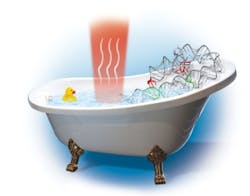Precision temperature control facilitates single-molecule research
Infrared (IR) laser light can quickly and precisely heat water in tiny containers to facilitate single-molecule and nanoparticle microscopy studies, report researchers at the National Institute of Standards and Technology (NIST, Bethesda, MD) and JILA, a joint institute of NIST and the University of Colorado at Boulder.1 Their demonstration extends a technique used to study single living cells. Fast, noncontact heating of very small samples is expected to enable new types of experiments with single molecules. For example, sudden, controlled jumps in temperature could be used to activate molecular processes and observe them in real time.
The technique is faster, more controllable and less prone to damaging expensive optics or accidentally altering chemistry than conventional methods, which use electric currents. Focused from above, IR light heats a nanoscale column of water within a 35 pL container on a glass slide; the beam can be moved to make the column warm single molecules attached to the slide. The laser offers a much larger dynamic temperature range (20° to 90°C) than bulk heating methods; in early trials, the technique controlled heating to .5°C in less than 20 ms across a micrometer-scale area.
1. E. D. Holmstrom and D.J. Nesbitt. J Phys Chem Lett 1: 2264-2268 (2010)
More BioOptics World Current Issue Articles
More BioOptics World Archives Issue Articles

